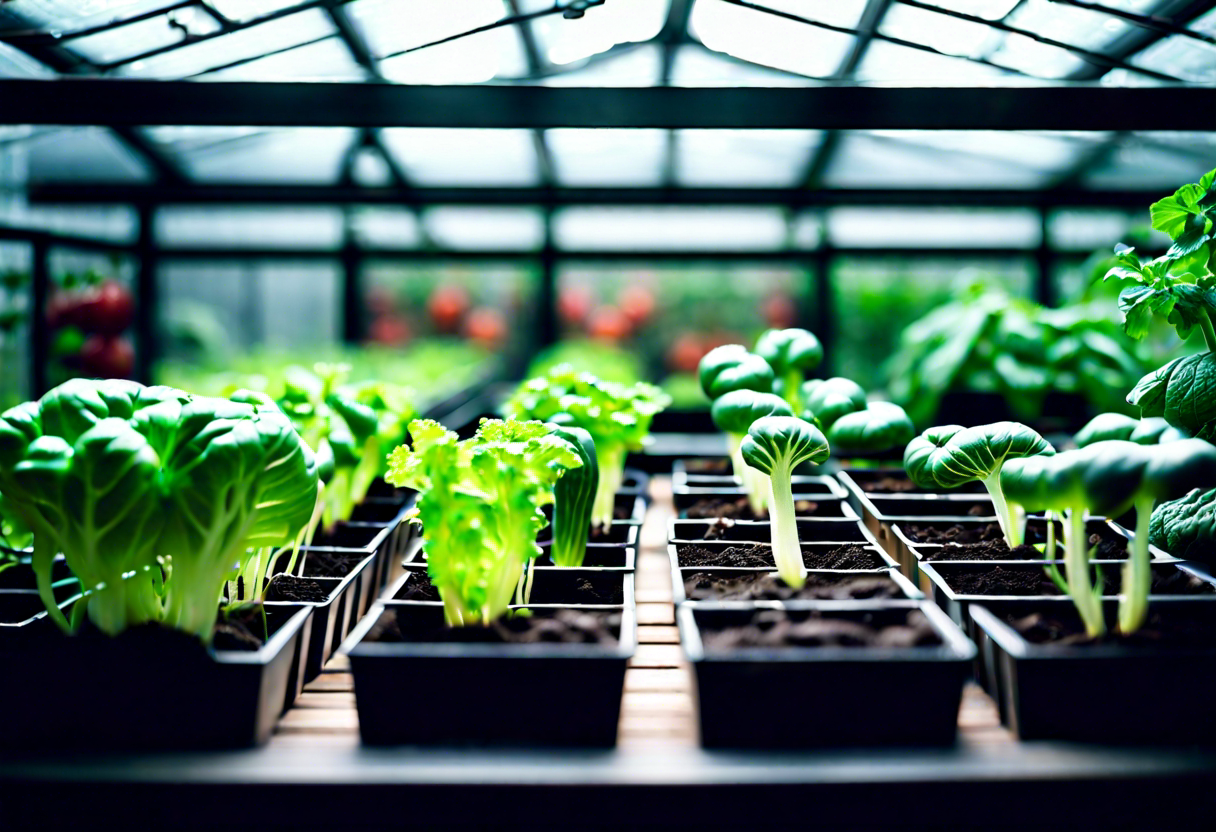Benefits of an Indoor Vegetable Garden System
Growing your own vegetables can be a rewarding and fulfilling experience. However, not everyone has access to a backyard or outdoor space for a traditional garden. This is where an indoor vegetable garden system can be a game-changer. Whether you live in a small apartment or a house with limited outdoor space, an indoor garden allows you to enjoy the benefits of gardening all year round. Here are some of the advantages of incorporating an indoor vegetable garden system into your home:
1. Fresh and Organic Produce
One of the major benefits of an indoor vegetable garden system is the ability to grow your own fresh and organic produce. With this system, you have control over the quality of the soil, the types of fertilizers used, and the absence of harmful pesticides. This means you’ll have access to vegetables that are free from chemicals and pesticides, ensuring a healthier and tastier harvest.
2. Year-Round Availability
Unlike outdoor gardens that are subject to seasonal limitations, indoor vegetable garden systems provide you with a year-round supply of fresh produce. By creating a controlled environment with the right temperature, lighting, and humidity levels, you can grow vegetables in any season. This means you’ll have a consistent supply of homegrown vegetables, regardless of the weather conditions outside.
3. Space-Saving Solution
Indoor vegetable garden systems are an excellent option for those with limited space. Whether you have a small balcony, a countertop, or a windowsill, you can find a system that fits your available space. Vertical garden systems, hydroponic setups, and self-watering containers are just a few examples of space-saving solutions that can help you maximize your indoor gardening potential.
4. Therapeutic and Stress-Relieving
Gardening has been proven to have numerous therapeutic benefits. Taking care of your indoor vegetable garden system can help reduce stress, improve your mood, and provide a sense of accomplishment. The act of tending to your plants, watching them grow, and eventually harvesting the fruits of your labor can be a deeply rewarding experience.
5. Educational Opportunities
An indoor vegetable garden system can also be a valuable educational tool, especially if you have children. It offers the opportunity to teach them about the plant life cycle, photosynthesis, and the importance of sustainable food practices. It can also encourage healthy eating habits as children become more engaged with the vegetables they’ve grown themselves.
An indoor vegetable garden system provides a host of benefits, from access to fresh and organic produce to year-round availability and educational opportunities. It’s a space-saving solution that can be therapeutic and rewarding, no matter the size of your home. So, why not bring the joys of gardening indoors and start your own indoor vegetable garden system today?
Choosing the Right Indoor Vegetable Garden System for Your Space
Growing your own vegetables indoors can be a rewarding and convenient way to enjoy fresh produce year-round. Whether you have a small apartment, a spacious kitchen, or a limited outdoor space, there are various indoor vegetable garden systems that can fit your needs. When choosing the right system for your space, consider the following factors:
1. Available Space
Before purchasing an indoor garden system, assess the available space in your home. Measure the area where you plan to set up the system, taking into account the height, width, and depth. This will help you determine the appropriate size and design of the system that will fit comfortably in your space.
2. Lighting Options
Lighting is crucial for indoor gardening, as plants need sufficient light to grow and thrive. Consider the type of lighting options provided by the system. Some indoor garden systems come with built-in LED lights, which are energy-efficient and provide the necessary spectrum for plant growth. Others may require additional lighting fixtures or natural sunlight. Choose a system that suits your lighting preferences and requirements.
3. Hydroponic or Soil-Based
Indoor garden systems can be either hydroponic or soil-based. Hydroponic systems use water and nutrient solutions to grow plants, while soil-based systems use traditional pots or containers with soil. Hydroponic systems tend to be more efficient in water usage and can result in faster growth. Soil-based systems offer a more traditional gardening experience and may be easier to manage for beginners. Consider your gardening goals and expertise when deciding between the two options.
4. Plant Capacity
Determine the number and types of vegetables you want to grow in your indoor garden system. Some systems are designed to accommodate a few small pots, while others have multiple tiers or shelves for growing a variety of plants. Choose a system that provides enough space for your desired plant capacity and allows for future expansion if needed.
5. Maintenance and Ease of Use
Consider the level of maintenance and ease of use required by the indoor garden system. Some systems are fully automated and come with timers and self-watering features, making them ideal for busy individuals or those with limited gardening experience. Others may require more hands-on care, such as regular watering and plant monitoring. Choose a system that matches your lifestyle and gardening skill level.
6. Budget
Indoor garden systems vary in price depending on their size, features, and brand. Set a budget before shopping for a system and consider the long-term costs, such as electricity usage and replacement parts. Compare different options within your budget range to find the best value for your investment.
By considering these factors, you can choose the right indoor vegetable garden system that suits your space, gardening goals, and lifestyle. Enjoy the benefits of growing your own fresh and delicious vegetables all year round!
Setting up an Indoor Vegetable Garden System
If you’re looking to enjoy fresh homegrown vegetables all year round, setting up an indoor vegetable garden system is a great solution. Not only does it allow you to have a sustainable and convenient source of produce, but it also adds a touch of greenery and freshness to your indoor space. In this step-by-step guide, we will walk you through the process of setting up your own indoor vegetable garden system.
1. Choose the Right Location
The first step in setting up an indoor vegetable garden system is finding the right location in your home. Look for a spot that receives ample sunlight, preferably near a south-facing window. If natural light is limited in your space, you can supplement it with grow lights. Ensure that the chosen location is easily accessible and well-ventilated to provide optimal growing conditions for your plants.
2. Select the Appropriate System
Next, choose the type of indoor vegetable garden system that suits your needs and space. There are various systems available, including hydroponic systems, aquaponics, and soil-based container systems. Consider factors such as your available space, budget, and gardening experience when making your selection.
3. Gather Necessary Supplies
Once you’ve determined the type of system, gather the necessary supplies. This may include containers, grow lights, a water reservoir, growing medium, and seeds or seedlings of your chosen vegetables. Make sure to choose containers that have drainage holes to prevent waterlogging and ensure proper aeration for the plant roots.
4. Prepare the Growing Area
Prepare the growing area by cleaning and disinfecting the containers to prevent the spread of diseases and pests. If you’re using a soil-based system, fill the containers with a well-draining potting mix. For hydroponic or aquaponic systems, set up the water reservoir and add the appropriate nutrient solution for plant growth.
5. Plant and Care for Your Vegetables
Now it’s time to plant your chosen vegetables. Follow the seed packet instructions or plant the seedlings in the prepared containers, ensuring proper spacing between plants. Provide adequate water and monitor the moisture levels to prevent over or under watering. Adjust the lighting and temperature according to the specific needs of your vegetables.
6. Maintain and Harvest
Maintain your indoor vegetable garden system by regularly monitoring for pests, diseases, and nutrient deficiencies. Address any issues promptly to ensure the health and productivity of your plants. As your vegetables mature, harvest them at the right stage of ripeness for maximum flavor and nutritional value.
By following these steps, you can create a thriving indoor vegetable garden system that allows you to enjoy the benefits of homegrown produce all year round. Remember to continuously learn and adapt your gardening practices to optimize the growth of your plants and maximize your harvest.
Essential Tips for Maintaining and Caring for Your Indoor Vegetable Garden System
Having an indoor vegetable garden system can be a rewarding and convenient way to enjoy fresh and nutritious produce right at home. However, like any garden, it requires regular maintenance and care to ensure healthy plant growth and abundant harvests. Here are some essential tips to help you maintain and care for your indoor vegetable garden system:
1. Provide Adequate Lighting
Light is crucial for the healthy growth of your indoor vegetable garden. Make sure your plants receive sufficient light by placing them near a window with good sunlight exposure. Alternatively, you can use artificial grow lights specifically designed for indoor gardening. Position the lights about 6 to 12 inches above the plants and adjust the duration of light exposure depending on the specific needs of each vegetable.
2. Temperature and Humidity Control
Most vegetables thrive in temperatures between 60°F and 75°F (15°C and 24°C). Make sure to monitor the temperature in your indoor space and adjust it accordingly. Provide adequate ventilation to prevent the buildup of excess heat or excessive humidity, which can lead to fungal diseases. Use a thermometer and a hygrometer to keep an eye on the temperature and humidity levels within your indoor vegetable garden system.
3. Watering Schedule
Water your indoor vegetable garden system regularly but avoid overwatering. It’s important to maintain a consistent moisture level in the soil, allowing it to dry slightly in between watering sessions. Check the moisture level by feeling the top inch of the soil with your finger. If it feels dry, it’s time to water. Avoid getting water on the leaves to prevent the development of diseases. Consider using a self-watering system or installing a drip irrigation system for convenient and efficient watering.
4. Fertilization
Indoor vegetable plants rely on you for their nutrient supply. Choose a balanced organic fertilizer specifically formulated for indoor gardens, and apply it according to the package instructions. Avoid over-fertilizing, as it can lead to nutrient burn or damage the plant roots. Regularly monitor the plant’s appearance and adjust the fertilization routine as needed.
5. Pest Management
Even indoors, pests can find their way to your vegetable garden. Inspect your plants regularly for signs of pests such as aphids, spider mites, or whiteflies. If you notice any infestation, act promptly using organic pest control methods such as introducing beneficial insects, like ladybugs or predatory mites, or using neem oil or insecticidal soap. Regularly cleaning the leaves and maintaining good air circulation can also help prevent pest issues.
6. Pruning and Harvesting
Prune your vegetable plants regularly to promote proper growth and prevent overcrowding. Remove any dead or damaged leaves and branches to maintain plant health. Additionally, harvest your vegetables when they are fully mature. Regular harvesting encourages the plants to keep producing and prevents them from becoming overgrown.
By following these essential tips, you can ensure the health and productivity of your indoor vegetable garden system. Enjoy the pleasure of growing your own fresh vegetables throughout the year, right in the comfort of your home.
The Best Vegetables to Grow in an Indoor Vegetable Garden System
When it comes to growing vegetables indoors, choosing the right plants is essential for a successful indoor vegetable garden system. While almost any vegetable can be grown indoors, certain varieties are more suitable for limited space and have higher chances of thriving in an indoor environment. Here, we will discuss some of the best vegetables to grow in an indoor vegetable garden system.
-
Leafy Greens: Leafy greens like lettuce, spinach, kale, and Swiss chard are excellent choices for indoor gardening. These vegetables have shallow root systems, making them well-suited for containers. They also have a relatively short maturity period, allowing you to enjoy fresh greens in a matter of weeks.
-
Herbs: Herbs like basil, parsley, thyme, and cilantro are popular choices for indoor gardening. They require minimal space and can be harvested frequently to enhance the flavor of your dishes. Many herbs are adaptable to different light conditions, making them suitable for various indoor environments.
-
Microgreens: Microgreens are young vegetable seedlings that are harvested just after the first leaves have developed. These delicate and nutritious greens can be grown quickly in an indoor vegetable garden system. Popular microgreens include radish, arugula, broccoli, and mustard.
-
Peppers: Peppers, both sweet and hot varieties, can thrive in an indoor garden with sufficient light and warmth. Compact pepper cultivars are available, which are well-suited for small containers. Remember to provide support as the plants grow to prevent them from toppling over.
-
Tomatoes: Though they require more space and care compared to other vegetables, tomatoes can be successfully grown indoors. Choose determinate varieties that stay compact or opt for smaller-sized tomatoes. Provide support with stakes or cages and ensure adequate light for proper fruit development.
-
Radishes: Radishes are fast-growing root vegetables that can be easily grown in an indoor vegetable garden system. They mature quickly, usually within a month, and can be harvested at different stages for various flavors and textures. Radishes thrive in cooler temperatures, making them ideal for indoor cultivation.
-
Beans: Dwarf varieties of beans, such as bush beans or pole beans, can be grown indoors with proper trellising for support. These legumes can add a touch of greenery to your indoor garden while providing you with a fresh supply of tasty beans.
Remember to consider the specific requirements of each vegetable, including light, temperature, humidity, and spacing, to ensure optimal growth. Provide adequate ventilation, water, and nutrients to your plants, and monitor them regularly for any signs of pests or diseases. By choosing the right vegetables for your indoor vegetable garden system and providing them with proper care, you can enjoy a bountiful harvest right from the comfort of your home.
Conclusion
Having an indoor vegetable garden system can provide numerous benefits for gardening enthusiasts, regardless of their space limitations. The ability to grow fresh, organic produce at home not only ensures a readily available supply of healthy food but also offers a sense of fulfillment and satisfaction. By choosing the right indoor vegetable garden system that suits your space, you can optimize plant growth and yield. The step-by-step guide to setting up an indoor vegetable garden system provides a clear understanding of the process and helps beginners embark on their gardening journey with confidence.
Maintenance and care are crucial aspects of ensuring the success of your indoor vegetable garden system. By following essential tips such as providing adequate lighting, watering properly, and pruning as needed, you can create a conducive environment for your plants to thrive. Regular monitoring of soil moisture levels, pest control, and fertilization will help maintain the overall health of your garden. With proper attention and care, your indoor vegetable garden system can provide a continuous supply of fresh, nutritious produce.
When it comes to selecting the best vegetables to grow in an indoor vegetable garden system, it is important to consider the space available and the specific requirements of each plant. Leafy greens such as spinach, lettuce, and kale are popular choices due to their compact growth and quick harvesting time. Herbs like basil, cilantro, and mint can also thrive indoors and add flavor to your culinary creations. Compact varieties of tomatoes, peppers, and cucumbers can be grown with the help of trellises or cages, making them suitable for limited space.
An indoor vegetable garden system offers numerous benefits, including a readily available supply of fresh produce, regardless of space limitations. By choosing the right system and following a step-by-step guide, setting up an indoor vegetable garden becomes an achievable task. Regular maintenance and care, along with the appropriate selection of vegetables, ensure a successful and bountiful harvest. So, why wait? Start your indoor vegetable garden system today and experience the joy of homegrown, organic vegetables right at your fingertips. Happy gardening!


